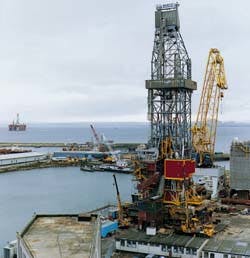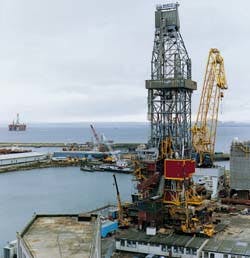Offshore Europe
UK fields start leveling out
Up to 15 new UK fields could be developed annually over the next few years, according to a report by the operators' association UKOOA. Towards 2020, based on members' estimates of known and future discoveries, envisages:
- 4-6 new oil developments per annum in the Northern and Central North Sea.
- 1 new oil development/yr west of the Shetlands.
- 1 new gas/condensate development annually in the Central North Sea.
- 4-6 new gas developments/yr in the Southern Gas Basin.
- 1 new gas development/yr in the Irish Sea.
Oil production from committed existing fields is expected to peak at 2.9MM b/d in 1996-7, declining markedly after the turn of the century. New fields, however, could sustain total production from that point to 2020 at around 1.3MM b/d.
Gas production from guaranteed field developments should peak around 8.5 bcf/d for the next five years, and supplies from new fields could boost that total to over 10 bcf/d, tailing off to 4 bcf/d by 2020. However, with the UK gas market currently saturated any upsurge is tied to the ability of marketers to export supplies through the Interconnector pipeline to continental Europe.
Net outlay for these levels of activity is put at a constant 8-10 billion for the next few years.
Three small new oilfields are adding to the equation. BP's South Magnus in block 211/12a is the first of several likely subsea tiebacks to the Magnus Field platform, where declining production has led to spare capacity. South Magnus' first producer well should be operational this month at 15,000 b/d, with a water injector three months later to sustain production. Reserves are put at 20MM bbl over a 10-year lifespan.
Fergus, claimed to be the UK's most southerly oilfield, will be a fast-tracked, four mile tieback to the Uisge Gorm floater currently working on the Fife Field. Operator Amerada Hess aims for a production start late this year at 12,000 b/d following modification work this summer.
Mobil opted for a long-reach well from its Beryl A platform for the Tay accumulation (recently onstream) on the basis that subsea development would have cost twice as much. A longer producer well is now planned from the platform (A64) with a T/D of nearly 20,000 ft and horizontal displacement of 14,000 ft.
Outside UKOOA's equations, Enterprise Oil reports a gas discovery flowing at 12.6 million cf/d in Rotliegendes sandstone in the Southern North Sea, six miles from Amoco's Davy platform.
Revised target for J-block oil
The new derrick equipment set for Shell Esso's Brent C platform at Consafe's yard in Fife, Scotland. Following testing and commissioning, the unit should enter service on the field this summer where it will be operated by Deutag drilling in depths down to 22,000 ft.
Oil should finally flow from Phillips UK's Judy/Joanne Field next April, a year behind schedule. Production planning was disrupted when Enron Europe, the sole purchaser of the field's gas, decided not to take any supplies until September 1997. Phillips was forced to consider reinjection of the gas into the J-Block reservoirs, as the oil could not be produced separately. The proposed scheme, recently approved by the UK government, will involve construction by Amec of a 700-ton gas injection module for the Judy platform. Hydrocarbon recovery wil only be boosted by 5%, and unfortunately for Phillips, the $82million outlay will swallow over half the savings accrued from the original Judy/Joanne budget outlay.
However, even though cashflow will be impacted near term, long term the project's economics remain favorable, the company claims. The J-Block partners are already drilling other prospects nearby such as Jacqui, Jade, and Joyce.
Dismal UK gas prices also caused BP to shelve expansion of its Bruce project last year. Plans had tentatively been drawn up to develop the western part of the field, involving 12 new wells (extended reach and tiebacks to a subsea manifold).
However, Trafalgar John Brown has now been awarded a pre-sanction contract for design and management of a 2.6 tcf second-phase development which would take into account better than expected performance from the first-stage wells. TJB will also advise on options for the western area reserves, thought to include a third platform to handle additional process equipment.
Tax regime hinders marginal developments
Knut Aam, former head of Phillips Norway, has called for tax incentives to spur development of up to 70 small fields lying fallow off the Norwegian shelf. Aam pointed out that 10-20MM bbl oilfields were being developed off Denmark and the UK, whereas 50MM bbl seemed to be the cut-off point in Norway.
However, most upcoming Norwegian field developments are large-scale, and explorationists are also targeting large new accumulations in northern waters. Geco Prakla's m/v SeisRanger, for instance, is embarking on a 75-day tour above the Gjallan Ridge for Saga Petroleum. 1,600 sq km of 3D seismic will be shot in waters 1,400 meters deep.
Planning is less certain in mid-Norway's Haltenbanken, where gas plans for the Asgard development may have to be scaled down. The oil companies' Gas Supply Committee set an export target of 10.8 bcm/yr from Asgard to meet contracts from French and German distributors. However, the Industry and Energy Ministry has proposed downgrading that figure to 8.9 bcm/yr until 2006, with Statoil's Troll and Norsk Hydro's Oseberg Fields making up the 2 bcm shortfall. This would obviously suit Hydro, which has long argued the case for Oseberg gas, but might seriously disrupt construction planning for Asgard.
The supplies are booked for continental Europe's burgeoning gas-fired power station program. Norway, too, is now considering building its own stations, but any schemes would have to take into account the country's strict linits on CO2 emissions.
Long-reach record for Texaco
The jacket for Texaco's HP/HT Erskine gas condensate development left fabricator Lewis Offshore recently. EPIC contractor Saipem should by now have installed the structure, comprising a four-leg vertical tower with flared base and six vertical skirt piles. The matching deck should be fitted next April following completion of the first three development wells.
Erskine and Tartan used to hold the record for long reach wells drilled by Texaco in the North Sea. But these have been overtaken by the recent M8 well on Strathspey, with its TD of 17,800 ft. Completion involved a horizontal section crossing three geological faults. Aside from adding new production, the well also penetrated the Brent reservoir for future development appraisal purposes.
Texaco is also gearing up to develop the small Galley oil and gasfield in Quad 15 via a floating production system. Bids are currently being evaluated. Storage is not mandatory, as hydrocarbons are likely to be piped to either the Tartan or Piper B platforms.
Copyright 1996 Offshore. All Rights Reserved.

